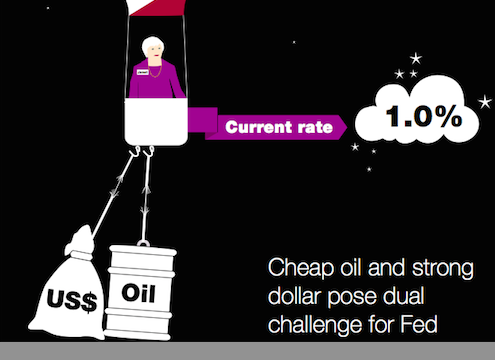Low inflation has been an unwelcome thorn in the side of the US Federal Reserve (Fed) and remains the most elusive piece of the Fed’s interest rate puzzle. The decision to raise interest rates in December was predicated on consistent growth in the US jobs market and an assumption that this would eventually feed through to higher inflation. However, the sluggish outlook for inflation has been a key reason why the market’s expectations for further interest rate hikes this year have been delayed. But inflation has recently shown signs of stirring again, with the Fed’s core measure of inflation increasing by 1.7% over the year, a level close to its target of 2%. This has surprised investors and puts into question the consensus view that inflation is likely to remain below the Fed’s target for an extended period. As commodity prices potentially form a base we pose the question: ‘Are investors too complacent about US inflation?’
When looking at the key factors that drive US inflation, we can see that external inputs (mainly the oil price and the US dollar) have had a significantly negative impact on inflation readings over the past 18-24 months (see Figure 1). This does not come as much of a surprise, as within that time frame we have seen the price of Brent crude oil fall from circa US$100 per barrel in mid-2014 to US$40 per barrel currently, and the US dollar has appreciated strongly versus most major currencies. What is of greater interest is the extent to which these transient factors have been implicitly priced into future estimates for inflation, and that the more persistent drivers of inflation — which have been operating in a more normal fashion — have been largely overlooked.
The Federal Reserve Bank of St. Louis recently attempted to quantify the mispricing of inflation expectations by extracting the implied expectations of future oil prices from the breakeven expectations of inflation rates. Assuming that the non-energy elements of the CPI basket are at historically normal levels, inflation expectations are so low that they imply the oil price would reach zero by 2019 – a wholly unrealistic assumption in itself. This exercise illustrates that if the core elements of the CPI basket remain robust, energy prices have to remain at very low levels going forward for inflation to meet current expectations. If the logic of this analysis is reversed and we take a view that energy prices do stabilise, or even rise in line with the forward curve, it raises a more pertinent point; that the market is expecting almost non-existent rates of non-energy CPI over the next year. Providing the US economy does not fall into recession, it is hard to believe that these expectations will materialise.
Clearly the case for higher headline inflation rates is dependent on the path that oil prices will take over the next year. While the oil price is likely to be volatile in the near term, we think that highlighting a range of plausible scenarios can be helpful in understanding the potential range of inflation outcomes. We model five potential scenarios that range from oil prices testing the lows and rebounding to reaching the market consensus of US$60 per barrel by the end of the year.
Taking this one step further we calculate the year-on-year contributions using these oil price estimates, energy weightings and the historical elasticity between energy CPI and the oil price. We can see from Figure 2 that the strong negative contribution of energy to CPI ties in with the steep drop in oil prices we witnessed at the end of 2014 and beginning of 2015. This negative effect diminished as oil prices stabilised and started to recover. We can see that by the end of 2016 energy prices are likely to positively contribute the CPI, even in the more conservative scenarios.
While the central case is that inflation rates remain well contained, it is naïve to ignore the potential risk that the market could be surprised by higher inflation rates. Our nowcasting models suggest inflation and wages will be firm going forward and our commodity team believes that robust oil demand and a material decline in oil supply will provide support to the oil price. If there is a more sustained oil price recovery, consistent with our commodity team’s forecast of approximately US$60 per barrel, there is a meaningful risk that inflation could even overshoot to the upside. This is a tail risk that neither the bond, currency or equity markets are prepared for.
Philip Saunders is Co-Head of Multi-assets at Investec.




